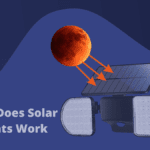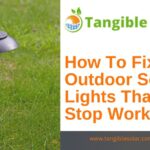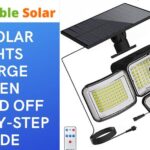What to Do With Broken Solar Lights: Repair and Rebuild?
To fix broken solar lights, start by checking the batteries and replacing them if necessary. Discover the untapped potential of broken solar lights. Learn how to repurpose them to reduce waste and create innovative DIY projects that benefit both your wallet and the environment.
Understanding The Potential Of Broken Solar Lights
Have you ever wondered what to do with those broken solar lights lying around? Instead of tossing them out, you might be surprised to learn that there are plenty of opportunities for repair and repurposing. By understanding the potential of broken solar lights, you can turn what may seem like trash into something useful and sustainable.
Let’s delve into how you can assess their value and recognize the possibilities for repair and repurposing.
Assessing The Value Of Broken Solar Lights
When it comes to broken solar lights, it’s essential to assess their value before deciding how to proceed. Here are some considerations to keep in mind:
Why are my solar lights blinking
- The extent of damage: Evaluate the level of damage inflicted on the solar light. Is it a minor issue or something more severe?
- Replaceable parts: Determine if any parts of the solar light are replaceable. Sometimes, a simple component replacement can bring the light back to life.
- Original cost: Consider the original cost of the solar light. If it was on the pricier side, it may be worth attempting repair rather than purchasing a new one.
Recognizing The Opportunities For Repair And Repurposing
Broken solar lights may no longer serve their original purpose, but that doesn’t mean they’re completely useless. Here are some opportunities for repair and repurposing:
- Repairing: Some common issues with broken solar lights can be easily fixed. Consider troubleshooting the circuitry, replacing batteries, or cleaning the solar panel to revive the light’s functionality.
- Decorative accents: Even if the solar light can no longer generate power, it can still be repurposed as a decorative accent. Place it in your garden or patio to add a touch of charm and ambiance to your outdoor space.
- Alternative power sources: salvage the solar panels from broken lights to create small DIY projects like solar-powered phone chargers or portable lights.
- Education and experimentation: Broken solar lights can serve as valuable learning tools for educational purposes or as experimentation objects for those interested in understanding solar-powered systems better.
By understanding the potential of broken solar lights and exploring avenues for repair and repurposing, you can contribute to a more sustainable lifestyle. So, instead of discarding those broken lights, get creative and give them a second chance at usefulness.
Repairing Broken Solar Lights
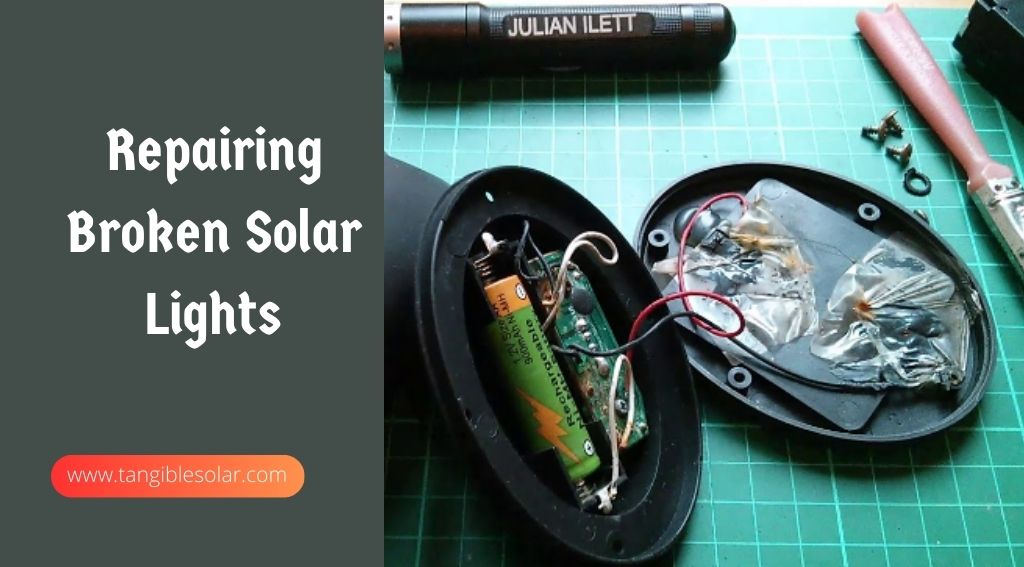
Discover effective solutions for repairing broken solar lights and make the most of your investment. Easily fix broken components and restore the functionality of your solar lights, ensuring a well-lit outdoor space that is both sustainable and cost-effective.
Having broken solar lights can be frustrating, but before you toss them out, why not try repairing them yourself? With a few simple tools and a little know-how, you may be able to get those lights shining bright again. In this section, we’ll cover common issues, troubleshooting tips, and a step-by-step repair process to help you bring your broken solar lights back to life.
Common Issues and Troubleshooting Guide:
When your solar lights aren’t working properly, it’s often due to one of these common issues:
- Dim or no light output:
- Battery failure
- Loose or damaged wiring
Let’s take a closer look at each problem and how you can troubleshoot it effectively.
Dim or No Light Output:
If your solar lights aren’t emitting enough light or are not working at all, it’s likely due to low battery power or faulty wiring. Here’s what you can do:
- Battery failure:
- Check if the battery is properly connected and has enough charge.
- Replace the battery with a new one if necessary.
- Loose or damaged wiring:
- Inspect the wiring connections for any loose or damaged wires.
- Repair or replace any faulty wiring to ensure a proper connection.
Step-by-step repair process:
Repairing your broken solar lights doesn’t have to be complicated. Follow these steps to troubleshoot and fix the issues:
- Gathering the necessary tools and materials:
- Screwdriver
- Wire cutters/strippers
- Multimeter (for testing purposes)
- Replacement batteries (if needed)
- Electrical tape
- Identifying and addressing the problem:
- Start by checking the battery and wiring connections for any visible issues.
- Tighten loose connections and fix any damaged wiring.
- Ensure the solar panel is clean and properly positioned to receive sunlight.
- Testing and replacing components:
- Use a multimeter to test the battery voltage and ensure it’s within the required range.
- If the battery is faulty, replace it with a new one of the same type and capacity.
- Test other components, such as the solar panel and light bulbs, and replace them if necessary.
- Safety precautions for handling broken solar lights:
- Always disconnect the solar light from power sources before attempting any repairs.
- Use insulated tools to avoid electrical shocks.
- Handle broken glass components carefully to prevent injuries.
By following these step-by-step instructions and taking necessary safety precautions, you can effectively repair your broken solar lights and extend their lifespan. So, don’t let those lights go to waste; give them a second chance to illuminate your outdoor space.
Creative Ideas For Repurposing Broken Solar Lights:
- Outdoor decor and lighting:
- Transform them into hanging lanterns for your backyard patio.
- Use them to create charming pathway lighting by placing them along the garden walkway.
- Attach them to garden stakes to make eye-catching solar-powered garden markers.
- Indoor lighting and accent pieces:
- Convert the solar light tops into colorful table lamps for your living room.
- String the broken solar lights together to craft a unique and whimsical light fixture for your bedroom.
- Create a cozy ambiance in your home office by repurposing the lights into a stylish desk lamp.
- Garden and plant-related projects:
- Transform the broken solar lights into dazzling solar-powered fairy lights to decorate your potted plants.
- Bury the solar panels in flowerbeds to create stunningly illuminated flower borders.
- Make use of the broken solar lights to craft enchanting hanging light orbs for your garden.
- Creating a solar-powered lantern:
- Gather your broken solar lights, mason jars, and some sturdy wire.
- Remove the tops of the solar lights and attach them securely to the lids of the mason jars with the wire.
- Place the solar panels in direct sunlight during the day and enjoy the atmospheric lighting at night.
- Building a solar-powered charging station:
- Gather your broken solar lights, a power bank, and a small wooden box.
- Remove the solar panels from the lights and attach them to the lid of the wooden box.
- Connect the solar panels to the power bank, and voila! You have an eco-friendly charging station for your devices.
With these repurposing ideas and step-by-step projects, you can breathe new life into your broken solar lights and enjoy their functionality in various ways. So, before you throw them away, get creative and let your imagination shine with these practical and eco-friendly DIY projects.
How to Stop Solar Lights from Flashing
Sustainability And Environmental Impact
Looking to dispose of your broken solar lights? Discover sustainable and eco-friendly solutions to minimize their environmental impact.
Benefits Of Repairing And Repurposing Broken Solar Lights:
- By repairing and repurposing broken solar lights, we can contribute to a more sustainable future. Here are the key benefits to consider:
- Reducing electronic waste: Instead of tossing broken solar lights into landfills, repairing and repurposing them helps to minimize electronic waste.
- Conserving resources and energy: By extending the lifespan of solar lights through repair, we reduce the need for manufacturing new units and conserve valuable resources and energy.
- Exploring sustainable alternatives: When we repair and repurpose broken solar lights, we encourage the exploration of sustainable alternatives to traditional lighting options.
- Replacing components instead of entire units: Repairing broken solar lights allows us to replace only the faulty components, significantly reducing waste and resource consumption.
- Utilizing renewable energy sources: Solar lights harness renewable energy from the sun, which is a clean and abundant source of power.
Reducing Electronic Waste:
- Repairing and repurposing broken solar lights helps in reducing the electronic waste that contributes to environmental pollution.
- Discarded solar lights in landfills can release harmful substances, such as heavy metals, into the environment.
- By opting for repair, we extend the lifespan of these lights, reducing the amount of electronic waste generated.
Conserving Resources And Energy:
- Repairing broken solar lights helps conserve valuable resources such as rare earth minerals, metals, and other raw materials required for manufacturing new units.
- By minimizing the production of new solar lights, we also save energy that would have been used in the manufacturing process.
- Conserving resources and energy is essential for a sustainable future and reducing our carbon footprint.
Exploring Sustainable Alternatives:
- Repairing and repurposing broken solar lights encourages the development and adoption of sustainable alternatives to traditional lighting options.
- It offers an opportunity to experiment with innovative designs and materials that are more eco-friendly and energy-efficient.
- By exploring sustainable alternatives, we can reduce reliance on non-renewable energy sources and promote a greener society.
Replacing Components Instead of Entire Units:
- Instead of replacing entire broken solar light units, we can often fix them by replacing faulty components.
- This approach reduces waste and conserves resources, as only the necessary parts need to be replaced or repaired.
- Repairing components also tend to be more cost-effective than purchasing entirely new units, making it a win-win from both an environmental and financial perspective.
Utilizing Renewable Energy Sources:
- Solar lights harness the power of renewable energy from the sun, making them an environmentally friendly lighting option.
- By utilizing solar energy, we reduce the demand for electricity generated from non-renewable sources such as coal or natural gas.
- Investing in solar-powered solutions like repaired solar lights helps to promote a sustainable energy future and mitigate climate change.
Repairing and repurposing broken solar lights not only benefits the environment but also contributes to a more sustainable and energy-efficient society. By reducing electronic waste, conserving resources and energy, exploring sustainable alternatives, replacing components instead of entire units, and utilizing renewable energy sources, we can make a positive impact on our planet.
So, let’s embrace the importance of sustainability and take action now to repair and repurpose those broken solar lights!
Tips For Extending The Lifespan Of Solar Lights
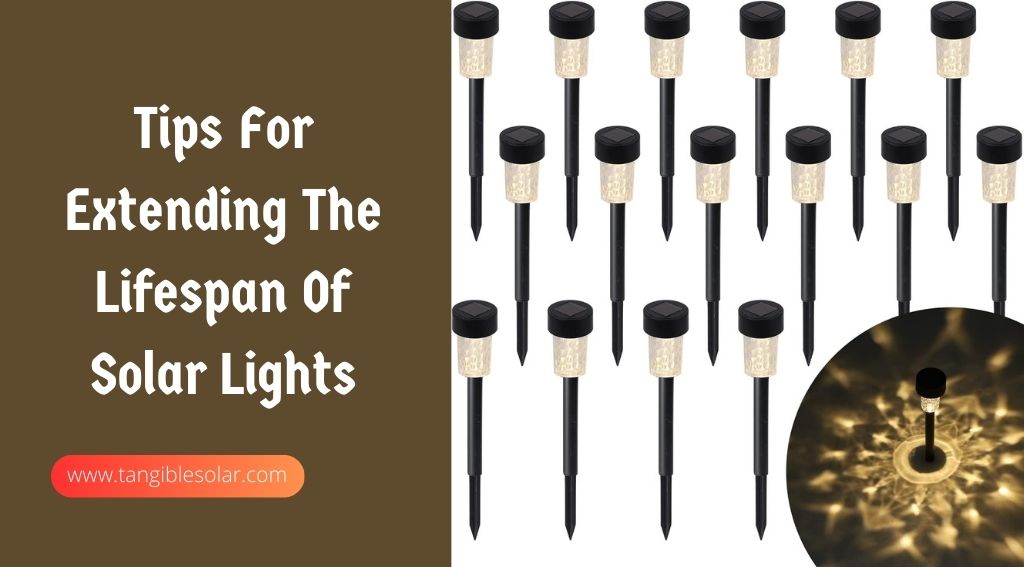
Extend the lifespan of your solar lights with these helpful tips. Learn how to deal with broken solar lights and ensure they last longer.
Proper maintenance and care:
- Inspect the solar lights regularly to identify any signs of damage or wear.
- Ensure that the solar panels are clean and free from dirt, dust, and debris.
- Check the batteries and replace them if they appear weak or worn out.
- Tighten any loose connections to ensure optimal performance.
- If you notice any faulty parts, promptly repair or replace them.
Regular cleaning and debris removal
- Clean the solar panels using a soft cloth or sponge and a gentle cleaning solution.
- Remove any dirt, grime, or residue that may reduce the efficiency of the solar panels.
- Clear away any leaves, branches, or other debris around the lights to prevent obstruction.
Protecting from harsh weather conditions:
- During severe weather conditions, such as heavy rain, storms, or snow, it is advisable to temporarily remove the solar lights and store them indoors.
- If this is not possible, cover them with a protective shield to shield them from the elements.
- Ensure that the materials used for covering are durable and weather-resistant.
Upgrading to more durable and reliable solar lights:
- Consider replacing broken or outdated solar lights with newer, more robust models.
- Look for solar lights with improved features, such as longer battery life and enhanced durability.
- Opt for lights made of high-quality materials that can withstand various weather conditions.
Selecting high-quality materials and construction:
- When purchasing solar lights, pay attention to the materials used for construction.
- Look for lights made of durable and long-lasting materials, such as stainless steel or aluminum.
- Ensure that the lights have sturdy and well-built construction to withstand external factors.
Considering waterproof and weather-resistant designs:
- Choose solar lights with waterproof and weather-resistant designs to ensure they can withstand rain, snow, humidity, and other outdoor conditions.
- Look for lights with an IP65 or higher rating, indicating their high level of resistance to water and dust.
By following these tips, you can help extend the lifespan of your solar lights and enjoy their benefits for years to come. Regular maintenance, cleaning, protection from harsh weather, and upgrading to durable models ensure optimal performance and longevity. Selecting solar lights with high-quality materials, construction, and weather-resistant designs further enhances their durability and reliability.
Top 5 Best Outdoor Solar Christmas Lights Reviews
So, make the most of your solar lights by taking proper care of them and ensuring their longevity.
Navigating The Market For Solar Lights
Navigating the market for solar lights can be challenging, especially when it comes to dealing with broken ones. Discover practical tips to handle and repurpose your malfunctioning solar lights efficiently.
Solar lights are an excellent option for illuminating your outdoor spaces while reducing your carbon footprint. With so many options available, it can be overwhelming to choose the right solar lights for your needs. To help you navigate the market effectively, we will explore the different types and designs of solar lights, compare their features and specifications, and provide tips for selecting the best ones.
Understanding The Different Types And Designs
Solar lights come in various types and designs, each serving a specific purpose. Here are the most common ones:
- Pathway lights: These solar lights are designed to line your pathway, creating a charming and well-lit walkway. They often come in stake designs that easily insert into the ground along your path.
- Spotlights and floodlights: If you want to highlight specific areas or features in your outdoor space, spotlights and floodlights are the perfect choice. They emit a focused beam of light, allowing you to accentuate trees, sculptures, or architectural elements.
- String lights and decorative options: To add a touch of whimsy and ambiance to your outdoor gatherings, consider solar string lights or decorative options. These lights can be hung across your garden, patio, or pergola, creating a magical atmosphere.
Comparing Features And Specifications
When selecting solar lights, it’s crucial to compare their features and specifications to ensure optimal performance. Consider the following factors:
- Solar panel efficiency: Look for solar lights with high-efficiency solar panels, as they efficiently convert sunlight into electrical energy. This, in turn, ensures better charging and longer illumination hours.
- Battery capacity and life: The battery capacity determines how long the lights will stay illuminated. Opt for solar lights with larger battery capacities to enjoy extended lighting durations. Additionally, pay attention to battery life, as it determines how long the batteries can last with frequent charging cycles.
- Lighting modes and settings: Some solar lights offer various lighting modes and settings, such as steady illumination or different flashing patterns. Choose lights that offer the versatility you desire for your outdoor space.
Now that you understand the different types, designs, and factors to compare, you are better equipped to choose the right solar lights for your needs. Assess your requirements and preferences, keeping in mind the available options in the market.
With a little research and consideration, you will find the perfect solar lights to enhance your outdoor ambiance while benefiting the environment.
Top 5 Best Outdoor Solar Hanging Lanterns
Frequently Asked Questions: What to Do With Broken Solar Lights?
Can solar lights be repaired?
Yes, solar lights can be repaired if there are any issues or malfunctions.
How Do You Fix a Broken Solar Light Wire?
To fix a broken solar light wire, follow these steps: 1. Identify the damaged section of the wire. 2. Cut out the damaged part using wire cutters. 3. Strip the insulation from both ends of the wire. 4. Connect the wires back together using wire connectors.
5. Use electrical tape to secure the connection. 6. Test the solar light to ensure it is working properly.
How long Should Solar Lights Last?
Solar lights typically last about 2-3 years, depending on usage and quality.
How To Use Dollar Tree Solar Lights?
To use Dollar Tree solar lights, simply place them in an area with ample sunlight, ensuring the solar panel is facing upward.
How Do I Fix a Broken Solar Light?
If your solar light is broken, check if the battery is working and replace it if needed. Also, consider replacing the solar panel or contacting the manufacturer for repairs.
Conclusion
Don’t let your broken solar lights go to waste! With a little creativity and resourcefulness, you can repurpose them into something useful or beautiful. Consider using the solar panels to power other small devices or electronics, or even create your DIY solar charger.
Get crafty by turning the broken lights into unique and decorative outdoor lanterns or hanging planters. Alternatively, you can salvage the parts and use them for repairing other solar lights in the future. Remember to dispose of any batteries responsibly, as they can be harmful to the environment if not handled properly.
By finding new uses for your broken solar lights, you not only save money and reduce waste but also contribute to a more sustainable and eco-friendly lifestyle. So, let your creativity shine and give those broken solar lights a new lease on life!


